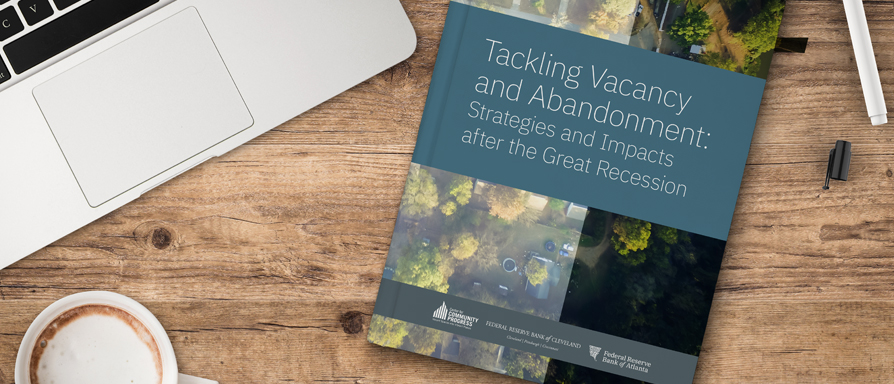Topic(s): Community Revitalization
New Research Publication Launched: Tackling Vacancy and Abandonment: Strategies and Impacts after the Great Recession
September 29, 2021

WASHINGTON, D.C. – Center for Community Progress announces the launch of Tackling Vacancy and Abandonment: Strategies and Impacts after the Great Recession, a research publication jointly produced with the Federal Reserve Banks of Atlanta and Cleveland. Community Progress is America’s leading nonprofit resource for urban, suburban, and rural communities seeking to equitably address the full cycle of property revitalization.
More than 10 years have passed since the Great Recession and the residential foreclosure crisis it unleashed. This crisis caused millions of Americans to lose their homes, leaving many neighborhoods with concentrated vacancy, disinvestment, and erosion of their local social fabric. In the aftermath of this crisis, researchers, practitioners, and organizations like the Center for Community Progress set to work analyzing vacancy interventions and shaping redevelopment strategies to stabilize neighborhoods.
Lessons from the Great Recession can help us assess and manage vacancy and abandonment in the uncertain times we now face in the midst of the COVID-19 crisis and its eventual aftermath. The pandemic has thrown existing inequities—particularly racial inequities—into stark relief, striking Black and Brown communities hardest in terms of both the impact of the disease and a shattered economic footing. Making the recovery from COVID-19 inclusive and equitable will require community leaders to understand the strategies deployed to address the last crisis and their impacts.
Tackling Vacancy and Abandonment: Strategies and Impacts after the Great Recession is a new edited volume that captures many of these efforts for practitioners, advocates, political leaders, and researchers looking to better understand the dynamics of vacancy and abandonment. It contains 12 articles by national experts in the field of neighborhood revitalization, including scholars from Georgia State University, the University of Michigan, the University of South Carolina School of Law, and the University of Utah, and practitioners from the Cuyahoga Land Bank, Atlanta Neighborhood Development Partnership, Reinvestment Fund, Enterprise Community Partners, the National Community Stabilization Trust, and the Center for Community Progress.
“We are proud to share this publication with the field, and hope that policymakers, practitioners, and community leaders value its insights around mitigating the negative effects of vacant and abandoned properties and promoting neighborhood revitalization,” said Akilah Watkins, president and CEO of Community Progress. “Given that the economic crisis spurred by the COVID-19 pandemic has affected many of the same low-income and predominately Black and Brown neighborhoods damaged by the foreclosure crisis, its lessons and outcomes are more relevant than ever to building an equitable and inclusive recovery.”
Tackling Vacancy and Abandonment: Strategies and Impacts after the Great Recession contains the following articles:
The Rise, Fall, and Rise of Vacant Properties as a Public Issue by Alan Mallach
The Battle of the Belts: Comparing Housing Vacancy in Larger Metros in the Sun Belt and the Rust Belt since the Mortgage Crisis, 2012 to 2019 by Austin Harrison and Dan Immergluck
Detroit’s Tax Foreclosure Problem by Margaret Dewar
People without Homes, Homes without People: Abandoned Properties as Opportunities for Affordable Housing in the Post-Disaster Reconstruction Environment by Ivis García and Luis Gallardo
Does a Nonprofit “First Look” Program Promote Neighborhood Stabilization? Examining Outcomes for REO Sales in Florida by Andrew Jakabovics and David Sanchez
Developing and Implementing Property Remediation Strategies in Urban and Rural Communities in the Lehigh Valley: A Case Study of Bethlehem and Northampton County, Pennsylvania by Emily Dowdall and Ira Goldstein
Ohio Land Banking 2009–2021: From Legislation to Operation by Gus Frangos
Approaches to Rural Property Vacancy in Law and Policy by Ann M. Eisenberg
Land Banks and Community Land Trusts: Emerging Partners for a Resilient and Equitable Recovery by Kim Graziani
Building Resilience: Leveraging Innovative Partnerships and Low-Cost Capital to Meet Affordable Single-Family Housing Needs by John O’Callaghan and Mandy Eidson
Resident Engagement in Vacant Lot Greening: Empowering Communities for Neighborhood Revitalization by Laney A. Rupp, Alison R. Grodzinski, Evaine K. Sing, Bernadette C. Hohl, and Marc A. Zimmerman
Next Steps by Frank S. Alexander
To download the publication in full, or any of its individual chapters, please visit https://communityprogress.org/publications/ccpfrbvolume/.
###
About the Center for Community Progress
Founded in 2010, the Center for Community Progress is the national leader for building strong, equitable communities where vacant, abandoned, and deteriorated properties are transformed into assets for neighbors and neighborhoods. Today, Community Progress has affected change in more than 48 states and seven countries through leadership education and collaborative systems, policy, and practice reforms. Simply, we work to transform “Vacant Spaces into Vibrant Places.”
About the Federal Reserve Bank of Atlanta
The Federal Reserve Bank of Atlanta sits in the Federal Reserve’s Sixth District and covers all of Georgia, Florida, and Alabama and portions of Louisiana, Mississippi, and Tennessee. The Atlanta Fed’s Community and Economic Development Department supports the Federal Reserve’s mandate of stable prices and maximum employment by working to improve the economic mobility and resilience of people and places for a healthy economy. To do this, we conduct research and create data tools to uncover the barriers to and opportunities for improved economic mobility as well as to make the data easily accessible for community and organization planning and decision-making. We engage stakeholders to help organizations and communities understand relevant issues and undertake cross-sector solutions. And we track and elevate issues facing the lower-income resident of the Southeast.
About the Federal Reserve Bank of Cleveland
The Federal Reserve Bank of Cleveland, the Federal Reserve’s Fourth District, covers all of Ohio, western Pennsylvania, eastern Kentucky, and the northern panhandle of West Virginia. The Cleveland Fed’s community development team promotes the economic resilience and mobility of low- and moderate-income people and communities throughout the Fourth District. We conduct research and engage with stakeholders on issues affecting access to credit, quality jobs, education, small business, and housing with the goal of increasing economic opportunity and helping people and communities thrive.
Subscribe to join 14,000 community development leaders getting the latest resources from top experts on vacant property revitalization.
